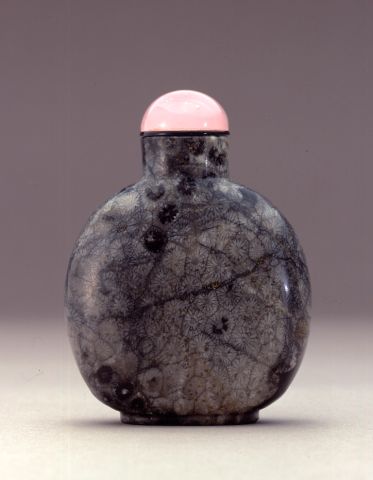
Bottle ID: 478
FOSSILIZED CORAL ROUNDED
Date: 1750-1860
Height: 60 mm
Fossilized coral, well hollowed, of flattened rounded form with shoulders sloping to a slightly everted concave mouth, and with a footrim with concave ovoid base, the stone of dark and light gray tones with irregular black splashes and natural lines, with a natural honey-comb pattern throughout.
Similar Examples:
Crane Collection no. 284
Stevens, Bob C. The Collector's Book of Snuff Bottles, 1976, p. 174, no. 681.
Hughes, Michael C. The Blair Bequest - Chinese Snuff Bottles from the Princeton University Art Museum, 2002, p. 86, no. 81.
Moss, Hugh, Victor Graham and Ka Bo Tsang. A Treasury of Chinese Snuff Bottles - The Mary and George Bloch Collection, 1998, Vol. 3, pp. 85-88, no. 401.
Provenance:
Clare Lawrence Ltd.
The Monimar Collection
Exhibited:
Christie's, St James's, London, June 1996
Annual Convention ICSBS Hong Kong, October 1996
Published:
Lawrence, Clare. Miniature Masterpieces from the Middle Kingdom - The Monimar Collection of Chinese Snuff Bottles, 1996, pp. 70-71, no. 29.130.
Fossiliferous stones with a vegetal origin, such as jet, are not strictly speaking minerals, as minerals have a crystalline form. However in the rock formation a vegetal matter can undergo a type of crystallization whereby the end product becomes a mineral, such as fossiliferous limestone. This is an organogenetic sedimentary rock which can be divided into three different groups – biohermal limestones ( a reef), biostromal limestones (shells) or pelagic limestones. As in the case of the stone used for this bottle, the structure of the once-living reef of coral colonies is preserved en masse, transforming into a coralline limestone, composed entirely of skeletons of colonial corals.
< Back to full list
 English
English 中文
中文